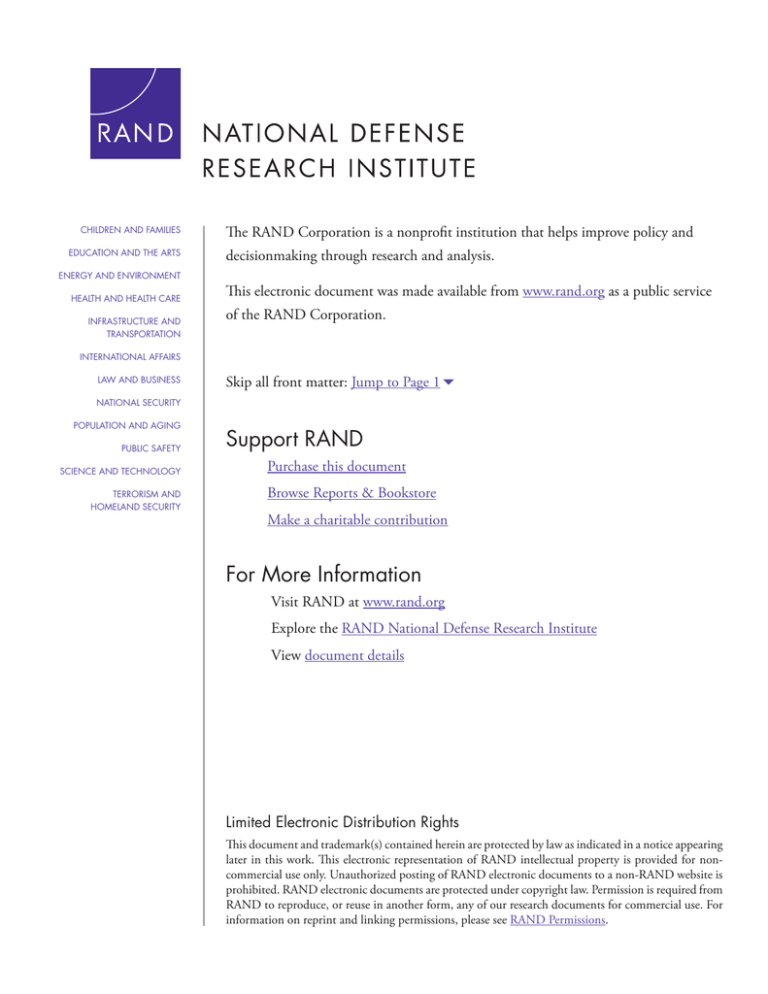The RAND Corporation is a nonprofit institution that helps improve... decisionmaking through research and analysis.
advertisement

CHILDREN AND FAMILIES EDUCATION AND THE ARTS The RAND Corporation is a nonprofit institution that helps improve policy and decisionmaking through research and analysis. ENERGY AND ENVIRONMENT HEALTH AND HEALTH CARE INFRASTRUCTURE AND TRANSPORTATION This electronic document was made available from www.rand.org as a public service of the RAND Corporation. INTERNATIONAL AFFAIRS LAW AND BUSINESS Skip all front matter: Jump to Page 16 NATIONAL SECURITY POPULATION AND AGING PUBLIC SAFETY SCIENCE AND TECHNOLOGY TERRORISM AND HOMELAND SECURITY Support RAND Purchase this document Browse Reports & Bookstore Make a charitable contribution For More Information Visit RAND at www.rand.org Explore the RAND National Defense Research Institute View document details Limited Electronic Distribution Rights This document and trademark(s) contained herein are protected by law as indicated in a notice appearing later in this work. This electronic representation of RAND intellectual property is provided for noncommercial use only. Unauthorized posting of RAND electronic documents to a non-RAND website is prohibited. RAND electronic documents are protected under copyright law. Permission is required from RAND to reproduce, or reuse in another form, any of our research documents for commercial use. For information on reprint and linking permissions, please see RAND Permissions. This report is part of the RAND Corporation research report series. RAND reports present research findings and objective analysis that address the challenges facing the public and private sectors. All RAND reports undergo rigorous peer review to ensure high standards for research quality and objectivity. NAT I O NA L D E FE N S E R E SEARCH INST IT U T E Penaid Nonproliferation Hindering the Spread of Countermeasures Against Ballistic Missile Defenses Richard H. Speier, K. Scott McMahon, George Nacouzi Prepared for the Naval Postgraduate School, Project on Advanced Systems and Concepts for Combating WMD Approved for public release; distribution unlimited This research was sponsored by the Defense Threat Reduction Agency and conducted within the International Security and Defense Policy Center of the RAND National Defense Research Institute, a federally funded research and development center sponsored by the Office of the Secretary of Defense, the Joint Staff, the Unified Combatant Commands, the Navy, the Marine Corps, the defense agencies, and the defense Intelligence Community under Contract W74V8H-06-C-0002. Library of Congress Cataloging-in-Publication Data ISBN: 978-0-8330-8149-0 The RAND Corporation is a nonprofit institution that helps improve policy and decisionmaking through research and analysis. RAND’s publications do not necessarily reflect the opinions of its research clients and sponsors. Support RAND —make a tax-deductible charitable contribution at www.rand.org/giving/contribute.html R® is a registered trademark. © Copyright 2014 RAND Corporation This document and trademark(s) contained herein are protected by law. This representation of RAND intellectual property is provided for noncommercial use only. Unauthorized posting of R AND documents to a non-R AND website is prohibited. RAND documents are protected under copyright law. Permission is given to duplicate this document for personal use only, as long as it is unaltered and complete. Permission is required from RAND to reproduce, or reuse in another form, any of our research documents for commercial use. For information on reprint and linking permissions, please see the RAND permissions page (www.rand.org/pubs/permissions.html). RAND OFFICES SANTA MONICA, CA • WASHINGTON, DC PITTSBURGH, PA • NEW ORLEANS, LA • JACKSON, MS • BOSTON, MA DOHA, QA • CAMBRIDGE, UK • BRUSSELS, BE www.rand.org Summary This research describes an approach to hindering the spread of countermeasures against ballistic missile defenses. (Such countermeasures, when incorporated in an attacker’s missile, are also called penetration aids, or penaids.) The approach involved compiling an unclassified list of penaid-relevant items that might be subject to internationally agreed-upon export controls. The list is formatted to fit into the export-control structure of current international policy against the proliferation of missiles capable of delivering weapons of mass destruction. This policy, the Missile Technology Control Regime, creates two levels of control. One is a set of tight restrictions against a small number of items, such as complete missiles or their major subsystems. The other is a set of case-by-case export reviews for lower-level components and dual-use items. This report recommends controls on 19 penaid-relevant items. More specifically, it recommends the tightest controls on three of those items: complete, integrated countermeasure subsystems; complete subsystems for missile defense test targets; and boost-glide vehicles. It offers as candidates for the tightest controls ten other items, such as re-entry vehicle replicas or decoys. But because these ten items are not complete subsystems, it identifies the possibility of treating them to a case-by-case review to improve the negotiability of the controls. Finally, the report identifies six classes of items, including test facilities and equipment, that could appropriately be subject to case-by-case review because of their utility for other applications, such as peaceful satellites. vii





